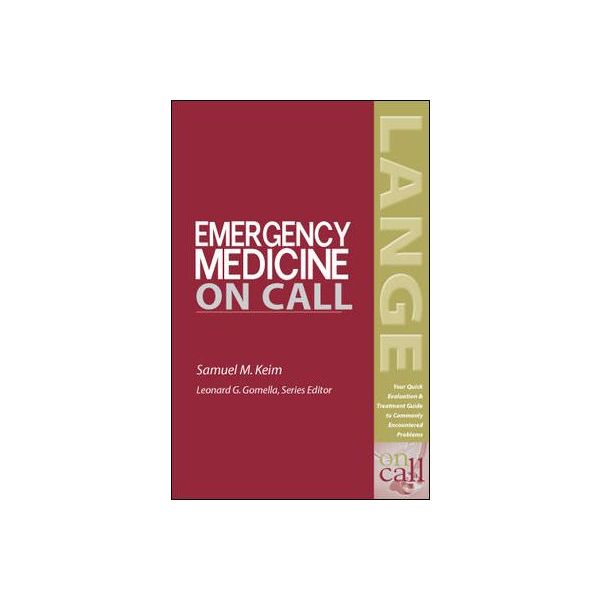EMERGENCY MEDICINE ON CALL
This user-friendly reference assists in the initial evaluation and treatment of the most frequently encountered problems in emergency medicine, both common and potentially life-threatening. The largest section of the book consists of 97 of the most common or important emergency medicine problems experienced by adult, pediatric, and geriatric populations. Each chapter in this section includes the presenting problem, immediate questions, differential diagnosis, laboratory and diagnostic data, and treatment plan. Additional chapters such as toxicologic emergencies, laboratory diagnosis, procedures, blood component therapy, and commonly used medications are also included and enhance the book's value as a single-source reference.
Key Features:
*Logically organized, quick-access reference to the evaluation and management of problems encountered in the emergency department setting - essential information is located immediately and provides a complete picture of the initial evaluation and treatment of specific problems
*Problem-oriented approach to the information is uniquely suited to the way in which emergency medicine is taught and practiced
*Differential diagnosis, key laboratoy and diagnostic tests, and treatment plans for 97 of the most commmon problems that present in the emergency department
*Chapters on laboratory and diagnostic tests, procedures, and commonly used medications - highlight important information in the management of the medical patient
| Author | KEIM |
|---|---|
| Table Of Content | I. Adult Emergency On-Call Problems1. Abdominal Pain2. Acid-Base Disorders3. Altered Mental Status4. Altitude Sickness5. Anaphylaxis6. Aneurysms7. Anxiety8. Back Pain9. Bites and Stings10. Bleeding Problems11. Bradycardia12. Cancer Problems13. Cardiac Arrest14. Cardiac Transplant Problems15. Chest Pain16. Congestive Heart Failure/Pulmonary Edema17. Consent to Treatment18. Constipation19. Cough in Adults20. Decubitus Ulcer21. Dental Pain and Infections22. Dermatologi Problems23. Diabetic Problems24. Dialysis Patient Problems25. Diarrhea26. Dizziness and Vertigo27. Drowning/Near Drowning28. Earache29. Epistaxis30. Ethical Dilemma31. Eye Pain/Red Eye32. Fever in Adults33. Foreign Body in Rectum34. Gastrointestinal Bleeding35. Gastrointestinal Catheter Problems36. Genitourinary Catheter Problems37. Headache38. Heart Murmur39. Hemophysis40. Hemorrhagic Shock41. Hernia42. Hiccups43. Hypertension44. Hostile Patient45. Hypertension46. Hyperthermia47. Hypotension48. Hypothermia49. Indwelling Catheter Problems50. Jaundice51. Joint Swelling52. Pacemaker Problems53. Palpitations54. Paresthesias55. Penile Problems56. Pregnancy Problems57. Psychiatric Problems58. Respiratory Distress59. Scrotal Problems60. Seizure61. Sepsis62. Sexual Assault63. Skin Infections64. Sore Throat65. Stroke/TIA66. Swollen, Warm, or Cold Extremity67. Syncope68. Tachycardia69. Transfusion Reactions70. Urinary Tract Problems71. Vaginal Bleeding/Discharge72. Weakness73. Wheezing in AdultsII. Pediatric On-Call Problems1. General Pediatric Assessment2. Abdominal Pain in Children3. Acute Life-Threatening Event (ALTE)4. Cough in Children5. Ear Pain in Children6. Febrile Infant7. Irritable Child8. Musculoskeletal Problems in Children9. Nonaccidental Trauma in Children10. Swallowed Foreign Body11. Vomiting and Diarrhea in Children12. Wheezing in ChildrenIII. Trauma Emergency On-Call Problems1. Trauma Assessment and Resuscitation2. Blunt Abdominal Trauma3. Blunt Head Trauma4. Burns5. Chest Trauma6. Electrical Injury7. Extremity Fractures and Dislocations8. Eye Trauma9. Facial Trauma10. Genitourinary Trauma11. Neck and Spinal Cord Trauma12. Needlestick13. Pelvic and Hip Trauma14. Trauma in PregnancyIV. Geriatric Emergency On-Call Problems1. General Geriatric Assessment2. Acute Myocardial Infarction in the Older Patient3. Altered Mental Status in the Older Patient4. Elder Abuse5. Falls in the Older Patient6. Functional DeclineV. Common Toxicologic Emergency On-Call Problems1. Acetaminophen2. Alcohols3. Amphetamine Overdose4. Anticholinergic Poisoning5. Benzodiazepine Overdose6. Beta Blocker Overdose7. Calcium Channel Blocker Overdose8. Cardiac Glycoside Overdose9. Caustic and Corrosive Ingestion10. Cocaine Overdose11. Cyclic Antidepressant Overdose12. Designer Drug Overdose13. Iron Overdose14. Organophosphate Poisoning15. Salicylate Overdose16. SSRI OverdoseVI. Terrorist Attacks1. General Terrorism Assessment and Response2. Biological Terrorism3. Chemical Terrorism4. Nuclear TerrorismVII. Laboratory DiagnosisVIII. Procedures1. Abscess Drainage2. Arterial Line Placement3. Arthrocentesis4. Bedside Ultrasound5. Central Venous Line Placement6. Cricothyrotomy7. Eye and Nose Procedures8. Intraosseous Line Placement9. Laceration and Wound Care10. Lumbar Puncture11. Paracentesis12. Peritoneal Lavage13. Procedural Sedation in Adults14. Procedural Sedation in Children15. Rapid Sequence Endotracheal Intubation16. Thoracentesis17. Thoracostomy Tube Placement18. Venous CutdownIX. Fluids and Electrolytes1. Introduction2. Prehospital3. Emergency Department and Fluid Management4. Selected Electrolyte EmergenciesX. Blood Component TherapyXI. Ventilator Management1. Indications and Set up2. Routine Modification of Settings3. Troubleshooting4. WeaningXII. Commonly Used Medications |
| Publish Date | 19 Aug 2003 |





